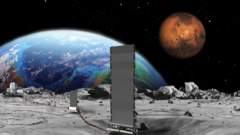NASA is accelerating plans to install a nuclear reactor on the Moon by 2030, as reported by U.S. media. This initiative aims to support a permanent human settlement on the lunar surface. Officials have pointed to similar aspirations from China and Russia and the potential for them to establish exclusive areas on the Moon.
However, skepticism lingers over the feasibility of the timeline, particularly following significant budget cuts to NASA. "To properly advance this critical technology... it is imperative the agency move quickly," wrote temporary NASA chief Sean Duffy, seeking proposals from private companies to design reactors capable of generating at least 100 kilowatts of power.
Building a nuclear reactor is not a completely novel idea; NASA awarded $15 million in contracts last year to develop designs. Moreover, China and Russia are eyeing a lunar nuclear power station by 2035. Many experts argue nuclear energy is the best option for sustained energy on the Moon due to its lengthy day-night cycle.
Dr. Sungwoo Lim from the University of Surrey emphasizes the need for megawatt-scale power for human habitats, stating, "Nuclear energy is not just desirable, it is inevitable." Professor Lionel Wilson from Lancaster University believes it’s technically feasible to land reactors on the Moon by 2030, provided sufficient funding and Artemis launches occur.
However, safety considerations regarding launching radioactive materials exist. Duffy's push for a lunar reactor comes amidst recent budget cuts that could hamper other scientific endeavors, like the Mars Sample Return mission. Scientists express concern over the geopolitical motivations driving these plans, warning that the rush for lunar dominance could overshadow key collaborative missions.
As nations race to explore and potentially claim territory on the Moon, the implications of establishing a nuclear reactor may lead to a new kind of territoriality in space, complicating future international cooperation.

















